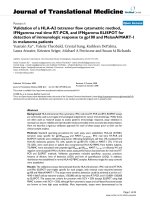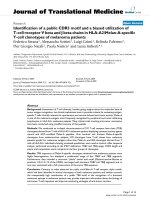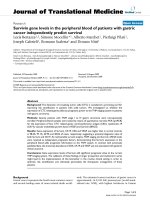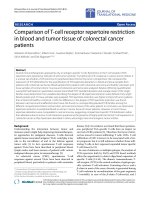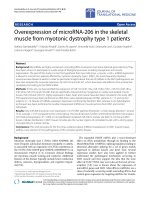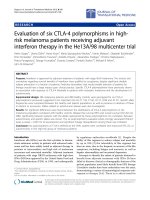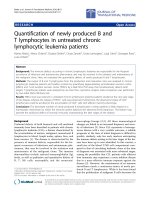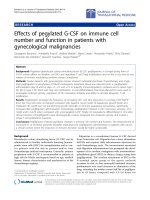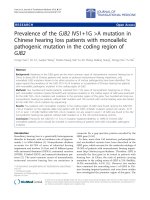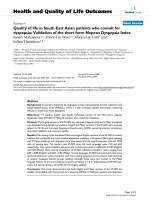báo cáo hóa học:" Engagement of patients in religious and spiritual practices: Confirmatory results with the SpREUK-P 1.1 questionnaire as a tool of quality of life research" ppt
Bạn đang xem bản rút gọn của tài liệu. Xem và tải ngay bản đầy đủ của tài liệu tại đây (279.39 KB, 11 trang )
Health and Quality of Life Outcomes
BioMed Central
Open Access
Research
Engagement of patients in religious and spiritual practices:
Confirmatory results with the SpREUK-P 1.1 questionnaire as a tool
of quality of life research
Arndt Büssing*1,2, Peter F Matthiessen1 and Thomas Ostermann1
Address: 1Department of Medical Theory and Complementary Medicine, University Witten/Herdecke, Gerhard-Kienle-Weg 4, 58313 Herdecke,
Germany and 2Krebsforschung Herdecke, Department of Applied Immunology, Heinrichstraße 67, 44805 Bochum, Germany
Email: Arndt Büssing* - ; Peter F Matthiessen - ; Thomas Ostermann -
* Corresponding author
Published: 06 September 2005
Health and Quality of Life Outcomes 2005, 3:53
doi:10.1186/1477-7525-3-53
Received: 20 July 2005
Accepted: 06 September 2005
This article is available from: />© 2005 Büssing et al; licensee BioMed Central Ltd.
This is an Open Access article distributed under the terms of the Creative Commons Attribution License ( />which permits unrestricted use, distribution, and reproduction in any medium, provided the original work is properly cited.
QuestionnairesReligion and MedicineSpirituality and Religionreligious practicescopingchronic disease, cancermultiple sclerosis
Abstract
Background: Quality of life is a multidimensional construct composed of functional, physical,
emotional, social and spiritual well-being. In order to examine how patients with severe diseases
view the impact of spirituality and religiosity on their health and how they cope with illness, we
have developed the SpREUK questionnaire. We deliberately avoided the intermingling of attitudes,
convictions and practices, and thus addressed the distinct forms and frequencies of spiritual/
religious practices in an additional manual, the SpREUK-P questionnaire.
Methods: The SpREUK-P was designed to differentiate spiritual, religious, existentialistic and
philosophical practices. It was tested in a sample of 354 German subjects (71% women; 49.0 ± 12.5
years). Half of them were healthy controls, while among the patients cancer was diagnosed in 54%,
multiple sclerosis in 22%, and other chronic diseases in 23%. Reliability and factor analysis of the
inventory were performed according to the standard procedures.
Results: We confirmed the structure and consistency of the previously described 18-item
SpREUK-P manual and improved the quality of the current construct by adding several new items.
The new 25-item SpREUK-P 1.1 (Cronbach's alpha = 0.8517) has the following scales: (1)
conventional religious practice (CRP), (2) existentialistic practice (ExP), (3) unconventional spiritual
practice (USP), (4) nature/environment-oriented practice (NoP), and (5) humanistic practice (HuP).
Among the tested individuals, the highest engagement scores were found for HuP and NoP, while
the lowest were found for the USP. Women had significantly higher scores for ExP than male
patients. With respect to age, the engagement in CRP increases with increasing age, while the
engagement in a HuP decreased. Individuals with a Christian orientation and with a religious and
spiritual attitude had the highest engagement scores for CRP, while the engagement in an USP was
high with respect to a spiritual attitude. Variance analyses confirmed that the SpR attitude and
religious affiliation are the main relevant covariates for CRP and ExP, while for the USP the SpR
attitude and the educational level are of significance, but not religious affiliation. Patients with
Page 1 of 11
(page number not for citation purposes)
Health and Quality of Life Outcomes 2005, 3:53
/>
multiple sclerosis overall had the lowest engagement scores for all five forms of SpR practice, while
it is remarkable that cancer patients had lower scores for HuP and USP than healthy subjects.
Conclusion: The current re-evaluation of the SpREUK-P questionnaire (Version 1.1) indicates
that it is a reliable, valid measure of five distinct forms of spiritual, religious and philosophical
practice that may be especially useful for assessing the role of spirituality and religiosity in health
related research. An advantage of our instruments is the clear-cut differentiation between
convictions and attitudes on the one hand, and the expression of these attitudes in a concrete
engagement on the other hand.
Background
Quality of life is a multidimensional construct composed
of functional, physical, emotional, social and (newly
introduced) spiritual well-being [1,2]. In breast cancer
patients, Levine and Targ [3] found significant correlations of spirituality and spiritual well-being with functional well-being, while items pertaining to meaning and
peace tended to correlate significantly with physical wellbeing. However, "spiritual well-being" itself is also a multidimensional construct. Murray et al. [4] described the
signs of spiritual well-being as "inner peace and harmony;
having hope, goals and ambitions; social life and place in
community retained; feeling of uniqueness and individuality; dignity; feeling valued; coping with and sharing
emotions; ability to communicate with truth and honesty;
being able to practice religion; finding meaning". Thus, it
is obvious that spiritual well-being is inextricably intertwined with the physical, social and emotional needs of
patients.
Within the last years scientific research approved several
connections between religion, spirituality, and health.
Several studies indicate that religious involvement and
spirituality are associated with better recovery from illness, greater longevity, coping skills, health-related quality of life, less anxiety and less depression (reviewed by [511]). As mentioned by Koenig [12], the findings are particularly strong in patients with severe or chronic diseases
who have stressful psychological and social changes, as
well as existential struggles related to meaning and purpose. Surveys suggest that most patients regard their spiritual health and physical health as equally important [5].
However, the measurability of a religious and/or spiritual
attitude respectively towards engagement in distinct
forms of a spiritual and religious practice is somewhat difficult. Even though the constructs Religiosity and Spirituality may not be identical, they were interchangeable to a
certain degree in their origins. Nowadays, it is well established practice to divide Religiosity into the three sub-constructs intrinsic, extrinsic, and quest religiosity [13-16]. In
contrast, the construct Spirituality is commonly divided
into the following sub-constructs: Cognitive Orientation
Towards Spirituality, Experiential/Phenomenological
Dimension of Spirituality, Existential Well-Being, Paranormal Beliefs, and Religiousness [17].
Due to their close contextual and cultural coherence, several inventories designed to measure spirituality ask for
specific and locally valid religious beliefs and practices
(i.e. church attendance and praying) and/or assume a
belief in God [17-23]. But this may be inappropriate for
patients with different religious, cultural or philosophical
backgrounds, or atheist or agnostic patients who may still
be spiritually oriented, but are not addressed with regard
to their distinct forms of practice in the inventories. A useful tool which does not assume a specific belief in God is
the Functional Assessment of Chronic Illness Therapy – Spiritual Well-Being (FACIT-Sp) [1,2]; however, it differentiates
only two factors, i.e. "faith", and "meaning and peace".
Another new inventory is our SpREUK questionnaire,
which asks for basic SpR attitudes and convictions (i.e.
Search for meaningful support; Positive interpretation of
disease; Trust in external guidance; Support in relations
with the External through SpR; Stabilization of the inner
condition through SpR). In order to examine how patients
with severe diseases view the impact of spirituality and
religiosity (SpR) on their health and how they cope with
illness, we previously performed several studies with this
new inventory [24-29]. We found that patients with both
a religious and spiritual attitude had significantly higher
values in the sub-scales dealing with the search for meaningful support, and the stabilizing effects of SpR than
patients without such attitudes, while patients with a nonspiritual religious attitude had lower perception of the
beneficial effects of their SpR and had significantly lower
scores in the search for meaningful support sub-scale [2426]. However, no significant differences were found in the
SpR attitude groups with regard to the meaning of disease.
Reflecting on meaning and sense of life and positive interpretation of disease obviously can have an impact on how
patients change their further life, and thus on distinct
forms and engagement frequencies of their SpR practice.
Depending on the strength of SpR beliefs and convictions
some may feel love and concern for others or have a sense
of connectedness, but those who are religious or spiritual
Page 2 of 11
(page number not for citation purposes)
Health and Quality of Life Outcomes 2005, 3:53
/>
Table 1: Demographic data and SpREUK-P scores of 354 subjects
%
CRP
(45.5 ± 27.6)
ExP
(60.9 ± 18.3)
USP
(32.0 ± 24.0)
HuP
(74.4 ± 20.0)
NoP
(69.9 ± 18.7)
sex
female
male
71
29
46.6 ± 27.3
42.5 ± 29.0
*
62.4 ± 18.1
56.9 ± 18.2
31.8 ± 24.9
32.1 ± 22.2
74.7 ± 19.8
73.4 ± 19.9
(*)
71.0 ± 18.3
67.1 ± 19.5
age
< 30 years
30–49 years
50–69 years
> 70 years
4
54
35
6
*
34.0 ± 32.8
41.5 ± 27.1
51.8 ± 27.2
50.7 ± 25.8
57.4 ± 21.2
60.6 ± 18.3
62.8 ± 17.7
55.9 ± 20.4
21.4 ± 19.1
32.5 ± 24.8
33.4 ± 23.9
25.4 ± 19.1
*
74.5 ± 23.1
75.8 ± 18.6
74.8 ± 19.1
60.5 ± 28.4
61.1 ± 22.9
69.0 ± 18.1
71.4 ± 19.7
74.2 ± 14.3
marital status
married
living with partner
divorced
alone
widowed
59
13
9
16
3
*
47.8 ± 27.1
37.6 ± 23.6
48.6 ± 26.8
38.2 ± 30.6
57.4 ± 30.5
**
58.3 ± 17.5
65.6 ± 16.3
72.2 ± 18.1
59.4 ± 22.0
56.1 ± 11.3
29.1 ± 21.3
32.9 ± 24.9
38.9 ± 28.7
34.1 ± 27.3
26.6 ± 21.9
74.0 ± 21.2
78.7 ± 16.7
74.1 ± 18.6
73.1 ± 19.3
71.3 ± 19.1
68.5 ± 18.6
70.4 ± 18.9
78.1 ± 19.7
67.6 ± 19.3
71.5 ± 13.7
education1
level 1
level 2
level 3
other
14
24
40
13
**
44.3 ± 26.1
38.2 ± 24.6
52.3 ± 28.8
36.8 ± 24.8
**
52.3 ± 18.6
57.5 ± 17.4
63.5 ± 17.5
67.0 ± 17.6
**
20.1 ± 19.7
24.3 ± 17.6
38.6 ± 26.4
34.3 ± 21.6
(*)
67.4 ± 22.8
74.1 ± 20.0
76.0 ± 18.8
76.5 ± 19.6
66.4 ± 22.7
70.9 ± 17.7
69.2 ± 18.0
75.0 ± 18.1
disease
Healthy
Chronic diseases
Multiple Sclerosis
Cancer
50
12
11
26
(*)
47.3 ± 28.8
41.6 ± 27.2
36.2 ± 28.3
46.4 ± 25.5
*
62.3 ± 16.6
64.7 ± 20.9
51.9 ± 17.9
60.1 ± 19.5
**
36.5 ± 25.3
35,5 ± 26.6
16.2 ± 15.3
28.6 ± 20.5
**
78.4 ± 15.8
78.4 ± 22.0
68.3 ± 27.8
68.0 ± 20.4
*
70.5 ± 19.0
73.9 ± 17.3
60.3 ± 20.7
72.2 ± 16.3
religious affiliation
Christian
Others2
None
84
3
13
**
50.4 ± 26.2
38.3 ± 32.6
16.0 ± 15.4
*
61.0 ± 17.5
73.8 ± 18.9
55.8 ± 20.8
31.8 ± 23.1
46.0 ± 35.7
29.4 ± 27.0
74.1 ± 19.9
72.2 ± 15.5
77.1 ± 20.6
70.0 ± 19.1
76.6 ± 13.3
67.6 ± 17.5
spiritual attitude
R+S+
R+SR-S+
R-S-
47
25
12
17
**
57.3 ± 24.3
51.3 ± 25.2
22.9 ± 18.7
18.8 ± 16.2
**
66.8 ± 17.0
55.3 ± 15.5
65.5 ± 16.1
47.6 ± 18.1
**
42.4 ± 22.2
19.6 ± 15.6
42.2 ± 26.7
12.2 ± 15.3
*
76.5 ± 18.2
70.5 ± 22.2
78.0 ± 16.4
71.1 ± 21.8
**
72.8 ± 16.8
67.6 ± 18.0
75.5 ± 14.7
61.9 ± 19.6
1 Increasing
educational level (based on German school system): 1 = secondary education (Hauptschule), 2 = secondary education (junior high;
Realschule), 3 = high school education (Gymnasium).
2 Islam, Buddhism, "Christengemeinschaft" and some not-specified confessions. Scores are significantly different (** p < 0.01; * p < 0.05; (*) 0.05 < p
< 0.10; ANOVA).
Deviations of >15% from the mean were highlighted.
only literally might not show any concern for others and
are self-centered.
Following these results, it is important to analyze the
forms of religious or spiritual involvement of the patients,
and to connect their engagement with the SpR attitudes
and their convictions how this may have an effect on the
course of disease. As the original SpREUK does neither ask
for distinct forms nor frequency of SpR practices, these
topics are addressed in the newly developped SpEUK-P
manual [26,27]. To account for the fact of an institutional
religion declines in Europe [30], and the alternative use of
various existing esoteric and religious resources, we
intended to ask for both, the conventional forms of SpR
(i.e. praying, service attendance, recitation of distinct
texts, reading distinct books, meditation etc.), and a more
reflecting or philosophical practice and nature/environment-oriented practice.
Page 3 of 11
(page number not for citation purposes)
Health and Quality of Life Outcomes 2005, 3:53
In this paper, we aimed to examine the statical properties
of this new SpREUK-P module and how it interacts with
the given SpREUK-scores.
Methods
Procedure and subjects
All individuals were informed of the purpose of the study,
were assured of confidentiality, and gave informed consent to participate. The patients were recruited consecutively in the cancer service, the multiple sclerosis service,
and two internal medical units of the Communal Hospital in Herdecke (West-Germany). The healthy subjects
were recruited among the medical staff of the Community
Hospitals in Herdecke and Berlin, staff of an ambulant
out-patient care unit in Essen, attendants of a meeting on
"Spirituality and Medicine" in Berlin, a Caritas congress in
Kevealer, and a meeting of contemporary Christian songwriters in Trier. All subjects completed the questionnaires
(SpREUK 1.1 and SpREUK-P) by themselves. Demographic information is provided in Table 1.
The sample contained 354 subjects of whom 71% were
women. The mean age was 49.0 ± 12.5 years. Half of the
subjects were healthy, while among the patients cancer
was diagnosed in 54%, multiple sclerosis in 22%, and
other chronic diseases in 23% (i.e. Hepatitis C, liver cirrhosis, inflammatory bowel disease, severe hypertension
etc.). Patients in final stages of their disease were not
enrolled.
Measures
The SpREUK-P was designed to differentiate spiritual, religious, existentialistic, and philosophical practices. The
items were developed with the patients' input (cancer
service of the Herdecke Community Hospital) and
experts' statements (physicians, therapists, and priest
working with patients) [26,27].
According to a previously conducted pilot study on the
reliability and factorial validity on the original 18-item
SpREUK-P 1.0 version [26], the following scales were
derived: (1) conventional religious practice (CRP), (2)
nature-oriented practice (NoP), (3) existentialistic practice (ExP), (4) unconventional spiritual practice (USP),
and (5) humanistic practice (HuP). As some of the scales
had only a few items, eight new questions (No. 19–26)
were added, in particular to strengthen the HuP construct.
In total, our item pool therefore consisted of 26 items. All
items were scored on a 4-point scale (0 – never; 1 – seldom; 2 – often; 3 – regularly). The SpREUK-P scores are
referred to a 100% level (4 "regularly " = 100%), which
reflects the degree of an engagement in the distinct forms
of a SpR practice ("engagement scores").
/>
Statistical analysis
Reliability and factor analysis of the new inventory were
performed according to the standard procedures. In order
to eliminate items from the item pool that were not contributing to the questionnaire reliability, the reliability of
the scale and distinct sub-scales was evaluated with internal consistency coefficients, which reflect the degree to
which all items on a particular scale measure a single (unidimensional) concept. To combine several items with
similar content, we relied on the technique of factor analysis, which examines the correlations among a set of variables, in order to achieve a set of more general "factors."
VARIMAX-factor analysis was repeated rotating different
numbers of items in order to arrive at a convergent solution embodying both the simplest structure and the most
coherent.
Differences in the SpREUK scores were tested using
ANOVA. We judged p < 0.05 significant, and 0,05 < p <
0.10 as a trend. To test the impact of several variables on
the SpREUK sub-scales, we performed analysis of univariate variance (ANOVA).
All statistical analyses were performed with SPSS for Windows 10.0.
Results
Reliability
Reliability analysis revealed that item "Church attendance" (P2) had a poor corrected item-total correlation
(Table 2) and thus should have been eliminated. However, as this item is of major conceptual importance (also
in other questionnaires), we decided not to eliminate it.
As shown in Table 2, the new construct had a good quality
(Cronbach's alpha = 0.8517). The item difficulty (1.65
[mean value]/3) is 0.55. With the exception of item P17
("I try to be aware of the way I treat the world around me";
item difficulty = 0.81), all values are in the acceptable
range from 0.2 to 0.8.
Factor analysis
Factor analysis revealed a Kaiser-Mayer-Olkin value of
0.79, which as a measures for the degree of common variance, indicates that the item-pool seems to be suitable for
a factorial validation. In addition, Barlett's test for nonsphericity was highly significant (p < 0,001).
Primary factor analysis of item pool pointed to a 7-factor
solution, which would explain 60.4% of variance. However, due to a low item number in the tentative subscales
6 and 7 (with 2 items each), we favored the more appropriate 6-factor solution, which explains 56.2% of variance
and is provided in Table 2.
Page 4 of 11
(page number not for citation purposes)
Health and Quality of Life Outcomes 2005, 3:53
/>
Table 2: Mean values of the items from SpREUK-P 1.1 and reliability parameters
Factors and Items
P2
P20
P19
P1
P13
P14
P11
P15
P10
P16
P7
P4
P8
P6
P5
P23
P22
P24
P25
P26
P3
P17
P18
P9
P21x
Mean value
(Score 0–3)
SD
Factor load
Item
difficulty
Corrected
Item-Total
correlation
Alpha if Item
deleted
(α = 0.8517)
1.30
0.87
1.37
1.66
0.94
0.98
1.03
0.99
0.794
0.779
0.772
0.692
0.44
0.29
0.46
0.55
0.116
0.266
0.414
0.499
0.858
0.851
0.846
0.843
1.65
2.01
2.07
1.23
2.08
1.91
0.80
0.75
0.75
0.91
0.75
0.77
0.782
0.667
0.606
0.568
0.520
0.436
0.55
0.67
0.69
0.41
0.70
0.64
0.318
0.483
0.682
0.531
0.460
0.432
0.849
0.844
0.838
0.842
0.845
0.846
0.92
0.91
0.99
1.24
0.71
1.04
0.93
1.02
1.15
0.86
0.768
0.723
0.682
0.595
0.534
0.31
0.31
0.33
0.41
0.24
0.450
0.471
0.577
0.371
0.483
0.844
0.844
0.839
0.826
0.844
2.31
2.41
1.98
2.30
2.26
2.21
0.56
0.58
0.70
0.58
0.66
0.70
0.774
0.746
0.717
0.650
0.574
0.445
0.77
0.80
0.66
0.77
0.75
0.74
0.319
0.355
0.370
0.302
0.340
0.499
0.849
0.848
0.848
0.849
0.848
0.844
2.42
1.85
2.03
0.60
0.82
0.81
0.725
0.616
0.551
0.80
0.62
0.68
0.396
0.519
0.244
0.847
0.843
0.851
1.79
1.03
0.584
0.60
0.377
0.848
Conventional Religious Practice (α = 0.8642)
go to church:
participate in religious events:
religious symbols are important in private area
pray:
Existentialistic Practice (α = 0.7797)
work on my self-realization:
work on my spiritual development:
try to get insight (also into myself):
try to achieve a higher level of consciousness:
reflect upon the meaning of life:
try to convey positive values & convictions to others:
Unconventional Spiritual Practice (α = 0.7535)
work on a body-mind discipline:
meditate:
perform distinct rituals:
read religious/spiritual books:
recite distinct (i.e. holy) texts:
Humanistic Practice (α = 0.7907)
try to consider the needs of others:
try to help others:
thoughts are with those in need:
try to do good:
feel connected with others:
try make an effort for other people:
Nature-oriented Practice (α = 0.5853)
try to be aware of how I treat the world around:
try to have a healing effect on environment:
turn to nature:
Guardian Angel
belief in (my) Guardian Angel:
The 4-item sub-scale CRP had an alpha of 0.8642, the 6item sub-scale ExP had an alpha of 0.7797, sub-scale USP
with its 5 items had an alpha of 0.7535, and the sub-scale
HuP with its 6 items had a Cronbach's alpha of 0.7907,
while the 3-item sub-scale NoP had an alpha of 0.5853. As
the item P21x ("Guardian angel") made up a factor on its
own – even in a tentative 5-factor solution -, we decided
to use it as a marker item until the construct is revised for
this topic. Thus, the internal consistency of the item pool
was sufficiently high.
Analysis of the "side-loadings" of the item pool (only values > 0.35 were take into account) revealed that the
marker item P21x ("guardian angel") together with items
P11 ("get insight") and P10 ("reflect upon the meaning of
life") from the ExP sub-scale and item P5 ("recite distinct
texts") from the USP sub-scale would load to a tentative
sub-scale 7, while item P21x would load only on the NoP
sub-scale 5 (0.368). However, this solution would
decrease the quality of the other respective sub-scales and
thus was rejected. Item P15 ("higher level of consciousness") from the ExP sub-scale also loads on the NoP subscale (0.388).
Relation between SpREUK-P scores and demographic
variables
The highest engagement scores were found for HuP and
NoP, while the lowest were found for the USP. Means and
standard deviations for study variables are provided in
Table 1.
Women had significantly higher scores for ExP than male
patients, and in trend also for NoP.
Page 5 of 11
(page number not for citation purposes)
Health and Quality of Life Outcomes 2005, 3:53
With respect to age, the engagement in CRP increases with
increasing age, while the engagement in a HuP decreases
with increasing age. Although not significant, it is remarkable that the lowest scores for USP were found in subjects
< 30 years and > 70 years of age.
With respect to the marriage status, subjects living alone
or with a partner but not married had the lowest scores for
CRP, whilst widowed patients had the highest engagement scores. This is in agreement with our previous findings that these individuals rely on "external guidance"
[25], but not the patients living with an unmarried partner. Divorced subjects had the highest engagement scores
for ExP (and, although not significant, for NoP) which is
again in accordance with our previous findings that they
are highly in search of meaningful support [25].
Engagement in USP, CRP and ExP depended on the educational level: Patients with higher educational level had
significantly higher scores than those with a lower level.
Only the NoP did not depend on educational level, while
for HuP we observed only a trend.
However, patients with MS overall had the lowest engagement scores, while patients with cancer or other chronic
diseases did not differ in regard of the engagement in
NoP, ExP and CRP. But it is somehow remarkable, that in
contrast to patients with other chronic diseases, the cancer
patients had lower scores for HuP and USP than healthy
subjects.
It is not surprising that individuals without any religious
affiliation had the lowest scores for the engagement in
CRP, while their engagement in USP was similar to that of
Christian subjects. The few individuals with religious affiliation other than Christian had the highest scores for USP
and ExP, but due to a too small investigation group, this
statement can be valued only as a hint. There were no significant differences between these three groups with
respect to an engagement in NoP and HuP.
Since nominational affiliation is not necessarily identical
with religiosity or spirituality, we asked whether the
patients would describe themselves as religious or spiritual [24-29]. 47 % of the 354 subjects analyzed herein
reported themselves as both religious and spiritual
(R+S+); 25% as religious, but not spiritual (R+S-); 17% as
neither religious nor spiritual (R-S-), while 12% claimed
that they were spiritual, but not religious (R-S+). Thus, the
numbers of patients with denominational affiliation and
self-reported spiritual/religious attitudes are somewhat
similar.
However, R+S+ subjects had the highest engagement score
for CRP (even higher than that of R+S-). The lower score
/>
of subjects with a R-S+ attitude was comparable with that
of R-S-. The engagement in an USP was high with respect
to a spiritual attitude (R+S+ and R-S+), while the lowest
scores were found for R-S- and R+S- subjects. It is remarkable that R-S- subjects had the lowest engagement scores
for all five forms of a SpR practice.
At present the item P21x ("belief in (my) Guardian
Angel"), which was a factor on its own, should be
regarded just as a marker item. We found significant differences in this item between the SpR attitude groups (F =
7.649; p < 0.0001). R+S+ had the highest belief score
(2.06 ± 0.932), followed by R+S- (1.75 ± 0.98), while RS+ and R-S- had less faith in their Guardian Angel (1.27 ±
1.16 resp. 1.14 ± 1.04). The highest belief scores were
found in widowed individuals (2.33 ± 0.58) and those >
70 years of age (2.25 ± 0.96), while the lowest score was
found in subjects < 30 years (1.13 ± 0.83). Women and
men did not significantly differ in their belief scores.
Analyses of variance
Next we tested the impact of several variables on the
SpREUK P sub-scales, such as age, sex, marital status, educational level, religious affiliation, SpR attitude, disease
and duration of disease. Using the method of univariate
analyses of variance we identified several sources of variability (Table 3):
• SpR attitude is an important covariate for four of the
distinct forms of practice (CRP, NoP, ExP and USP), but
not for the HuP.
• Religious affiliation is an important covariate for CRP
and ExP, but not for USP.
• Educational level is a covariate for USP and ExP.
• Gender andMarital status are covariates only for ExP.
• Age is not a relevant covariate for any of the five forms
of SpR practice.
• Disease itself has an impact on NoP (and a minor
impact on HuP and USP), while the duration of disease
has no impact on the forms of SpR practice. However, disease and its duration are of relevance for an engagement
in HuP.
Correlation between engagement in the different forms of
SpR practice and SpR attitude
Bivariate correlation between the five forms of a SpR practice revealed a strong correlation between NoP and ExP,
and between ExP and USP, while CRP did not correlate
with NoP or HuP, regardless of their SpR attitude (Table
4). For individuals with a spiritual attitude (R+S+ and R-
Page 6 of 11
(page number not for citation purposes)
Health and Quality of Life Outcomes 2005, 3:53
/>
Table 3: Univariate variance analyses
variables
(1) conventional religious practice
(2) existentialistic practice
(3) unconventional spiritual practice
Levene's test *
F-value
p-value
SpR attitude
age
religious affiliation
educational level
0.000
45.165
1.350
23.192
1.396
0.000
n.s.
0.000
n.s.
SpR attitude
age
religious affiliation
educational level
gender
marital status
gender * marital status
0.000
15.064
0.921
3.557
2.768
4.390
2.276
2.325
0.000
n.s.
0.030
0.040
0.037
0.029
0.056
SpR attitude
age
religious affiliation
educational level
disease
duration of disease
0.000
29.344
0.982
0.417
4.429
2.555
1.228
0.000
n.s.
n.s.
0.005
0.042
n.s.
0.007
0.028
n.s.
0.003
0.001
(4) humanistic practice
disease
duration of disease disease
* duration of disease
0.053
2.047
1.711
3.188
0.091
n.s.
0.002
(5) nature-oriented practice
SpR attitude
age
disease duration of disease
0.000
4.058
0.302
2.484
1.088
0.008
n.s.
0.046
n.s.
n.s.
In this table, only significant results were given.
*Levene's test for equality of variances was significant and thus the level of significance for the variance analyses should be p < 0.01
S+), their ExP is strongly associated with USP and NoP
(Table 4), while the ExP of R+S- individuals correlates
only with NoP, but not with USP. Moreover, for those
with a spiritual attitude (R+S+ and R-S+), their USP correlated well with CRP. However, the ExP of in R-S- individuals significantly correlated with a CRP.
As shown in Table 5, Pearson's correlation between the
SpR practice and the distinct SpR measures of the SpREUK
manual revealed strong correlations:
• CRP correlates with "Trust in external guidance" and
"Support in relations with the External life through SpR",
but not with "Positive interpretation of disease".
• ExP correlates well with "Search for meaningful support", "Support in relations with the External life through
SpR" and "Positive interpretation of disease".
• USP correlates well with "Support in relations with the
External life through SpR" and "Search for meaningful
support".
• HuP did not correlate at all with "Trust in external guidance" or "Support in relations with the Internal life
through SpR", but marginally with both "Support through
SpR" sub-scales.
• With respect to NoP, we found moderate correlations
with all five SpREUK subscales.
The item "Belief in (my) Guardian Angel" which was used
only as a preliminary marker item correlated moderately
with ExP (r = 0.301) and NoP (r = 0.290), and with the
SpREUK scales "Search for meaningful support" (r =
0.327) and "Support of the Internality through SpR" (r =
0.361), but somewhat higher with "Trust in external
Guidance" (r = 0.421). Surprisingly, also individuals without any religious affiliations reported that they often/frequently believed in their Guardian Angel (36%, resp. 46%
of R-S+ and 27% of R-S-), in contrast to 62% of the Christians (69% R+S+ and 62% of R+S-), and 86% of those
with non-Christian affiliations.
Page 7 of 11
(page number not for citation purposes)
Health and Quality of Life Outcomes 2005, 3:53
/>
Table 4: Pearson correlation between SpREUK-P sub-scales with respect to SpR attitude
CRP
all individuals
conventional religious practice
existentialistic practice
unconventional spiritual practice
humanistic practice
nature-oriented practice
R+S+ individuals
conventional religious practice
existentialistic practice
unconventional spiritual practice
humanistic practice
nature-oriented practice
R+S- individuals
conventional religious practice
existentialistic practice
unconventional spiritual practice
humanistic practice
nature-oriented practice
R-S+ individuals
conventional religious practice
existentialistic practice
unconventional spiritual practice
humanistic practice
nature-oriented practice
R-S- individuals
conventional religious practice
existentialistic practice
unconventional spiritual practice
humanistic practice
nature-oriented practice
ExP
USP
HuP
NoP
1.000
.230 **
1.000
.371 **
.490 **
1.000
.027
.316 **
.199 **
1.000
.066
.512 **
.302 **
.220 **
1.000
1.000
.019
1.000
.324 **
.429 **
1.000
-.047
.278 **
.216**
1.000
-.030
.505 **
.307 **
.284 **
1.000
1.000
.179
1.000
.255 *
.165
1.000
.119
.276 *
.070
1.000
.000
.450 **
.090
.'157
1.000
1.000
.056
1.000
.400 **
.465 **
1.000
-.167
.311 **
.055
1.000
.166
.581 **
.216
.329 *
1.000
1.000
.410 **
1.000
.227
.268 *
1.000
.083
.313 *
.164
1.000
-.030
.396 **
.153
.015
1.000
Bivariate correlations are statistically significant with * p < 0.05 and ** p < 0.01 (2-tailed significance)
Discussion
We have confirmed the structure and consistency of the
previously described SpREUK-P manual [26,27], which is
an integral part of the SpREUK construct [24-28], and
improved the quality of the current construct by adding
several new items. Apart from conventional religious and
unconventional spiritual practices, three other distinct
forms of engagement were of relevance to the patients
with life-threatening diseases, i.e. existentialistic practice,
humanistic practice, and nature/environment-oriented
practice. The latter three topics are obviously more philosophical forms of SpR.
When confronted with a life-threatening disease, more
existentialistic or self-centered issues become relevant to
the patients. Existentialistic philosophers (such as Søren
Kierkegaard and Jean-Paul Sartre) emphasized the univer-
sal struggle to find meaning in life, to live by moral standards, and to come to an understanding of suffering and
death [31,32]. To them, life might be without inherent
meaning (existential atheists) or it might be without a
meaning we can understand (existential theists). Consequently, since man is ultimately alone, one is free to pick
and choose one's own values, and to create one's own
suitable religious patchwork. In accordance with these
views we found strong correlations between ExP and the
SpREUK scales "Search for meaningful support" and "Positive interpretation of disease". Moreover, the ExP engagement score was much higher compared to the more
formalized practices, i.e. CRP and USP. The highest
engagement scores were found for HuP and NoP. One
could speculate that these forms reflect a higher level of
"insight", but it is also true that less effort is needed to
turn to others (HuP) and nature (NoP) than to reflect on
Page 8 of 11
(page number not for citation purposes)
Health and Quality of Life Outcomes 2005, 3:53
/>
Table 5: Pearson correlation between SpREUK sub-scales and SpR practice
Search Meaning
SpREUK-P engagement scores
conventional religious practice
existentialistic practice
unconventional spiritual practice
humanistic practice
nature-oriented practice
(Guardian Angel)
Message Disease
Trust Guidance
Support External
Support Internal
.381 **
.510 **
.551 **
.243 **
.322 **
.327 **
.093
.465 **
.385 **
.154 **
.284 **
.271 **
.659 **
.361 **
.330 **
.014
.190 **
.421 **
.472 **
.487 **
.560 **
.130 *
.314 **
.179 *
.367**
.433 **
.479 **
.112
.367 **
.361 **
Bivariate correlations are statistically significant with * p < 0.05 and ** p < 0.01 (2-tailed significance)
yourself (ExP); and their social desirability is much
higher. One the other hand, within recent decades, ecological issues and people's appreciation of nature ("earth
connection") have gained much attention, and thus
higher agreement levels are not surprising. Engagement in
an ExP is significantly dependent on the SpR attitude (low
engagement level were found for R-S- individuals and
those without any religious affiliation); gender and marital status are also relevant variables. One may speculate
that divorced individuals, who have the highest ExP
engagement level, reflect more on themselves because of
the process of divorce ("liberation", "self-realization").
A more self-centered attitude is also measured in a scale of
Holland's Spiritual Beliefs Inventory (SBI-15R-D) [19,33]:
The underlying attitude of a social support through a religious faith community can be described as "What will
others do for me?" In our HuP and NoP scales, the question is "What can I do for others, for nature and environment?" These contrasting views are highly affected by the
state of "insight" an individual has developed.
The items of the scale HuP are related to the views of Secular Humanism [34,35] and the Philosophical resp.
Christian Humanism [36]. Secular Humanism is an atheistic and naturalistic philosophy promoting humanity as
the measure of all things, and roots in the rationalism of
the 18th Century and the free-thought movement of the
19th Century. Secular Humanists reject the concept of a
personal creator God, and regard man as fully responsible
for the future of the world, its political systems, its ecology, etc. [34,35]. Thus, it is not surprising that the scale
HuP neither correlates to CRP nor to the SpREUK scale
"Trust in External Guidance". In fact, it correlates somewhat better with ExP and the SpREUK scale "Search for
meaningful support". Consequently, the lowest HuP
engagement levels were found for individuals lacking a
spiritual attitude (R+S- and R-S-). Low engagement levels
were also found with respect to higher age, and in patients
with cancer and MS. The impact of disease and its duration on HuP remains to be explained in further studies.
To our surprise, one of the most accepted topics defining
conventional religious practice, "going to church" resp.
"service attendance", had a low engagement score among
the German individuals tested. The same is true for the
participation in religious events, while praying seems to
be much more attractive. The items from the USP scale
had low engagement scores too, even meditation, which
is highly valued in several other questionnaires.
The presumption that both scales do not measure what
they are intended to do can be rejected both from a statistical but also from a contextual point of view, because
individuals with a Christian affiliation had significantly
higher engagement scores for CRP than those with other
religious affiliations or none, while individuals with nonChristian affiliations had the highest scores for USP.
Moreover, a religious attitude (R+S+ and R+S-) was associated with significantly higher mean levels for CRP than
subjects with a spiritual attitude (R-S+ and R-S+), while in
contrast a spiritual attitude (R+S+ and R-S+) was associated with higher levels for USP. In this context it is worth
mentioning that an R-S- attitude was associated with the
lowest engagement scores for all five forms of a SpR
practice. Variance analyses confirmed that SpR attitude
and religious affiliation are the main relevant covariate for
CRP, while for USP, the SpR attitude and the educational
level are of significance, but not religious affiliation.
The level of engagement in CRP also depends on the professional background of the tested subjects. We found that
the engagement score was very high in attendants of a
Christian Caritas meeting (mainly priests, chaplains,
Christian social workers etc.) and in composers of Contemporary Christian Songs (mean values 79.9 ± 20.3 resp.
77.0 ± 13.1); high scores were found also in attendants of
a meeting on "Spirituality and Health" (56.9 ± 33.3),
while the lowest CRP score was found in hospital staff
(32.7 ± 20.0). The engagement score of catholic nurses
caring for out-patients (45.7 ± 25.6) was similar to the
overall mean level (47.1 ± 28.8). Details of this investigation will be presented elsewhere.
Page 9 of 11
(page number not for citation purposes)
Health and Quality of Life Outcomes 2005, 3:53
Using the German version of Holland's Spiritual Beliefs
Inventory (SBI-15R-D), Albani et al. found that higher
religiosity is observed for women, older people, people
with lower education, former West Germans vs. former
East Germans, and people stating a religious affiliation
[33]. These findings are only in part congruent with ours:
The higher CRP engagement score in women was not statistically significant, while lower age and lower educational level were associated with significantly lower CRP
engagement scores. However, we can confirm higher
scores for patients with a Christian affiliation and a religious attitude (R+S+ and R+S-). Using the SpREUK 1.1
inventory, we have found that women with cancer have
significantly higher scores for "Search for meaningful support", "Interpretation of disease" and "Support in relations with the external life through SpR", but not for
"Trust in external Guidance"[24] Similar, cancer patients
with a lower educational level had significantly lower
scores for "Search for meaningful support" and "Interpretation of disease", though again not for "Trust in external
Guidance" [24]. Thus, it is obvious that the condensed 10item scale of the shortened SB-15-R [19], which measures
mainly religious beliefs and convictions dealing with the
support through God and faith, represents only a distinct
aspect of religiosity.
In fact, "religiosity" is already multidimensional construct. Batson et al. described a three-dimensional model
of religiosity: Means or external, End or internal, and
Quest [14, 37]. Intrinsic religiosity identifies religion as an
end in itself. Strong personal convictions, beliefs and values are what matter, while the social aspects of religion are
not that important. In contrast, the motifs of extrinsic
religiosity are based on social or external values and
beliefs; religion is used to gain social standing and
endorsement. The Quest orientation is founded on a willingness to question complex ideas. The persons are open
to the exploration of existential questions and they are
open for new information and doubts. Thus, as we have
to assume a complex interconnection of various existing
views, attitudes and concepts, an oversimplification ("two
scales are enough") of SpR concerns in QoL research is not
appropriate.
Conclusion
Our scales are in congruence with external factors influencing the distinct forms and frequency of a patients SpR
engagement. The SpREUK questionnaire with its SpREUKP manual thus could be of value in measuring SpR attitudes and engagement of patients coping with life-threatening illness, and in the measurement of distinct aspects
of QoL.
An advantage of our instruments is the clear-cut differentiation between convictions and attitudes on the one
/>
hand, and the expression of these attitudes in concrete
engagement on the other. A second advantage is the differentiation of five distinct forms of spiritual, religious
and philosophical practice. Finally the fact that the validation was performed in a sample with at least two different
types of life-changing diseases (cancer and MS, and other
chronic diseases) and a healthy control group is advantageous for interpreting the results.
In future studies we will emphasize the correlation our
scales with conventional QoL instruments. Nevertheless,
evaluation of the SpREUK-P questionnaire indicates that
it is a reliable, valid measure of distinct topics of SpR practices. The focus of a larger study is to enroll patients from
the highly secular Eastern Europe, and to run longitudinal
studies with cancer, multiple sclerosis patients, but also
cardiac failure and spinal cord damage.
The conventional SpREUK (Version 1.1) and its SpREUKP manual (Version 1.1) are currently available in English
and German.
Authors' contributions
AB conceived the study, designed and developed the questionnaire, performed statistical analysis and drafted the
manuscript. TO participated to conceive and design the
study assisted in statistical analysis and helped to draft the
manuscript. PFM participated in the design and development of the questionnaire. All authors read and approved
the final manuscript.
Acknowledgements
We are grateful to our patients and to Dr. Cristina Stumpf and Dr. Mette
Käder for their cooperation in recruiting them, and to Hugh Featherstone
Blyth for his grammatical support.
References
1.
2.
3.
4.
5.
6.
7.
8.
Brady MJ, Peterman AH, Fitchett G, Mo M, Cella D: A case for
including spirituality in quality of life measurement in
oncology. Psychooncology 1999, 8:417-428.
Peterman AH, Fitchett G, Brady MJ, Hernandez L, Cella D: Measuring spiritual well-being in people with cancer: the functional
assessment of chronic illness therapy–Spiritual Well-being
Scale (FACIT-Sp). Ann Behav Med 2002, 24:49-58.
Levine EG, Targ E: Spiritual correlates of functional well-being
in women with breast cancer. Integr Cancer Ther 2002,
1:166-174.
Murray SA, Kendall M, Boyd K, Worth A, Benton TF: Exploring the
spiritual needs of people dying of lung cancer or heart failure:
a prospective qualitative interview study of patients and
their carers. Palliat Med 2004, 18:39-45.
Mueller PS, Plevak DJ, Rummans TA: Religious involvement, spirituality, and medicine: implications for clinical practice. Mayo
Clin Proc 2001, 76:1225-1235.
Sloan RP, Bagiella E, Powell T: Religion, spirituality, and
medicine. Lancet 1999, 353:664-667.
Sloan RP, Bagiella E: Claims about religious involvement and
health outcomes. Ann Behav Med 2002, 24:14-21.
McCullough ME, Hoyt WT, Larson DB, Koenig HG, Thoresen C:
Religious involvement and mortality: a meta-analytic
review. Health Psychol 2000, 19:211-222.
Page 10 of 11
(page number not for citation purposes)
Health and Quality of Life Outcomes 2005, 3:53
9.
10.
11.
12.
13.
14.
15.
16.
17.
18.
19.
20.
21.
22.
23.
24.
25.
26.
27.
28.
29.
30.
31.
32.
Luskin F: Review of the effect of spiritual and religious factors
on mortality and morbidity with a focus on cardiovascular
and pulmonary disease. J Cardiopulm Rehabil 2000, 20:8-15.
Levine EG, Targ E: Spiritual correlates of functional well-being
in women with breast cancer. Integr Cancer Ther 2002,
1:166-174.
Seeman TE, Dubin LF, Seeman M: Religiosity/spirituality and
health. A critical review of the evidence for biological
pathways. Am Psychol 2003, 58:53-63.
Koenig HG: Religion, spirituality, and medicine: research findings and implications for clinical practice. South Med J 2004,
97:1194-1200.
Allport GW, Ross JM: Personal religious orientation and
prejudice. J Pers Soc Psychol 1967, 5:432-443.
Batson CD, Schoenrade PA: Measuring religion as Quest: Validity concerns. J Scien Study Religion 1991, 30:416-429.
Maltby J, Lewis CA: Measuring Intrinsic and Extrinsic Orientation Toward Religion: Amendments for its use among religious and non-religious samples. Personal Indiv Differences 1996,
21:937-946.
Maltby J, Day L: Amending a measure of the Quest Religious
Orientation: Applicability of the scale's use among religious
and non-religious persons. Personal Indiv Differences 1998,
25:517-522.
Bufford RK, Paloutzian RF, Ellison CW: Norms for the spiritual
well-being scale. J Psychol Theol 1991, 19:56-70.
Paloutzian RF, Ellison CW: Loneliness, spiritual well-being and
the quality of life. In Loneliness: A sourcebook of current theory,
research and therapy Edited by: Peplau LA, Perlman D. Wiley-Interscience; 1982:224-237.
Holland JC, Kash KM, Passik S, Gronert MK, Sison A, Lederberg M, et
al.: A brief spiritual beliefs inventory for use in quality of life
research in life-threatening illness.
Psychooncology 1998,
7:460-469.
Underwood LG, Teresi JA: The Daily Spiritual Experience
Scale: Development, Theoretical Description, Reliability,
Exploratory Factor Analysis, and Preliminary Construct
Validity Using Health-Related Data. Ann Behav Med 2002,
24:22-33.
Plante TG, Boccaccini M: The Santa Clara Strength of Religious
Faith Questionnaire. Pastoral Psychology 1997, 45:375-387.
Plante TG, Vallaeys C, Sherman AC, Wallston KA: The development of a brief version of the Santa Clara Strength of Religious Faith Questionnaire. Pastoral Psychology 2002, 50:359-368.
Sherman AC, Plante TG, Simonton S, Adams DC, Harbison C, Burris
SK: A multidimensional measure of religious involvement for
cancer patients: the Duke Religious Index. Support Care Cancer
2000, 8:102-109.
Bussing A, Ostermann T, Matthiessen PF: Search for meaningful
support and the meaning of illness in German cancer
patients. Anticancer Res 2005, 25:1449-1455.
Bussing A, Ostermann T, Matthiessen PF: Role of religion and spirituality in medical patients: confirmatory results with the
SpREUK questionnaire. Health Qual Life Outcomes 2005, 3:10.
Bussing A, Ostermann T, Matthiessen PF: Spirituelle Bedürfnisse
krebskranker Menschen – Einstellung und Praxis. Deutsche
Zeitschrift für Onkologie 2005, 37:13-22.
Bussing A, Ostermann T: Caritas und ihre neuen Dimensionen:
Spiritualität und Krankheit. In Caritas plus. Qualität hat einen
Namen Edited by: Patzek M. Kevelaer: Butzon and Bercker;
2004:110-133.
Ostermann T, Bussing A, Matthiessen PF: [Pilot study for the
development of a questionnaire for the measuring of the
patients' attitude towards spirituality and religiosity and
their coping with disease(SpREUK)]. Forsch Komplementarmed
Klass Naturheilkd 2004, 11:346-353.
Bussing A, Ostermann T, Matthiessen PF: Role of Religion and
Spirituality in Medical patients in Germany. Journal of Religion
and Health 2005, 44:321-340.
Jagodzinski W, Dobbelaere K: Der Wandel kirchlicher Religiosität in Westeuropa. Kölner Zeitschrift für Soziologie und
Sozialpsychologie 1993:68-91.
Kaufmann W: Existentialism: From Dostoevsky to Sartre. Plume Books
1975.
Sartre J-P: Being and Nothingness Washington Square Press; 1943.
/>
33.
34.
35.
36.
37.
Albani C, Bailer H, Geyer M, Brähler E, Grulke N: Erfassung
religiöser und spiritueller Einstellungen – Psychometrische
Überprüfung der deutschen Version des „System of Belief
Inventory" (SBI-15R-D) von Holland et al. an einer
repräsentativen Bevölkerungsstichprobe. Psychother Psych Med
2002, 52:306-313.
Kurtz P: A Secular Humanist Declaration New York: Prometheus
Books; 1980.
Kurtz P: The Humanist Alternative New York: Prometheus Books;
1973.
Holland J: Religious Humanism: The Past We Inherit; The
Future We Create. Humanism today 1998, 12:.
Batson CD, Schoenrade P, Ventis WL: Religion and the individual: A
social-psychological perspective New York: Oxford University Press;
1993.
Publish with Bio Med Central and every
scientist can read your work free of charge
"BioMed Central will be the most significant development for
disseminating the results of biomedical researc h in our lifetime."
Sir Paul Nurse, Cancer Research UK
Your research papers will be:
available free of charge to the entire biomedical community
peer reviewed and published immediately upon acceptance
cited in PubMed and archived on PubMed Central
yours — you keep the copyright
BioMedcentral
Submit your manuscript here:
/>
Page 11 of 11
(page number not for citation purposes)
